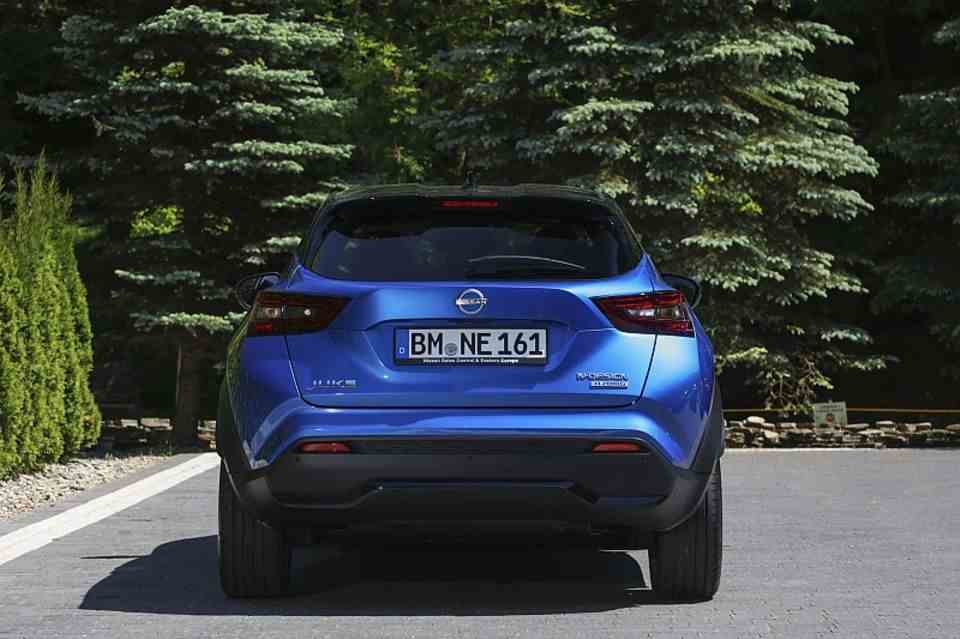Driving report Nissan Juke 1.6 Hybrid
Two birds with one stone
Nissan Juke 1.6 Hybrid
© press-inform – the press office
The Nissan Juke 1.6 Hybrid fulfills two customer requests at once. On the one hand it offers more power than before and on the other hand an electrification of the drive train. Small details reveal the close relationship to Renault Arkana and Captur.
The Nissan Juke has its wild years behind it. The Japanese crossover initially polarized with its expressive design, but the design language of the second generation is significantly more suitable for the masses. However, there was some resentment when the 84 kW / 114 hp version was driven. “Some customers wanted more power,” says product manager Philipp Müller. So it’s a good thing that the Nissan Juke wanted to go a step further in terms of power anyway. Electric, of course, to take account of the zeitgeist. After all, the Japanese want to bring 15 electric cars onto the market by 2030.
Therefore, the Nissan Juke 1.6 Hybrid with a system output of 105 kW / 143 PS satisfies the fans’ hunger for performance and underlines the electric ambitions. Wait a moment. Renault-Nissan, hybrid, 1.6 liters and 143 hp. Something rings. Exactly. The Nissan Juke shares the Renault-Nissan Alliance CMF-B platform with the Renault Captur and Renault Arkana. So the hybrid powertrain is also identical.
So the Nippon part-time electric vehicle also uses the power of the engine trio consisting of a 1.6-liter combustion engine with 69 kW / 94 hp, an electric motor (36 kW / 49 hp with 205 Nm) and the HSG generator (15 kW / 20 hp and 50 Nm). Overall, this results in a system output of 105 kW / 143 PS. The interface is the DogBox transmission, which is similar in characteristics to a CVT automatic, the principle of which comes from the Formula 1 cars. The starter generator is responsible for the ideal speed to compensate for the lack of synchronization of the transmission, which has four traditional gears for the combustion engine and two EV gears. In addition, the friction of the gearshift is greatly reduced, which helps with energy recovery and lowers consumption. Nissan specifies it as 5.1 liters per 100 kilometers. To improve aerodynamics, technicians installed a rear spoiler, covered the rear axle, changed the front apron and equipped the radiator grille with a blind.
On our first test drive, which also took us on the Autobahn, we got 6.5 l/100. On the fast sections we were briefly traveling at 140 km/h, which was close to the top speed of 166 km/h. As with other drive concepts, this unit also takes an extra sip from the petrol bottle when performance is required. When swimming along on country roads and in towns, consumption leveled off at 5.6 l/100 km. If you prefer recuperation, press the e-pedal button in the center console and activate the deceleration of 0.15 g as soon as you take your foot off the accelerator. However, this is only possible up to a speed of 5 km/h. If you want to come to a standstill, you have to use the analog brake in the classic way.
The consumption also reflects the driving behavior of the hybrid crossover in a special way. If you take it easy, the electrified powertrain shows its best side. Even in the Eco driving program, acceleration commands are obediently implemented, if you select the standard or sport mode, the response is even more immediate and the Juke lets dynamics flash. This is in the spirit of the Nissan managers, who want to breathe more sportiness into the crossover. That changes with a kick-down. Then the four-cylinder growls sullenly and the propulsion is more like a CVT transmission. The chassis of the Nissan Juke Hybrid approaches the concept of comfort from the firm side, a consequence of the weight of 1,343 kilograms, the wheelbase of 2.64 meters and the 19-inch wheels. Even if you always take note of potholes, the SUV never becomes uncomfortable.
There is praise for the space available in the 4.21 meter long vehicle. In the rear, there is also enough space for tall people. As with the two French relatives, the 37.5 kilogram 1.2 kilowatt hour battery is in the trunk. It is clear that this will result in losses in cargo space. So the load volume of the trunk melts by 68 liters compared to the conventionally fired Juke variants from 422 to 354 liters and with the seats folded down from 1,305 to 1,237 liters. This configuration reveals the technical relationship between the Juke and the Renault Arkana. Even with the Japanese, the loading floor is flat and there is a two-centimetre gap between the rear seats and the trunk. In addition, the loading sill is too high. The interior differs in detail from that of its conventional brothers. On the left of the seven-inch digital cockpit is a power meter instead of the usual rev counter. Otherwise, the infotainment is rather classic. An eight-inch touchscreen, Apple CarPlay and Android Auto – that’s essentially all. Even if the graphics of Nissan’s own navigation are rather old-fashioned, you can get along well with the entertainment program. But that also has its price of at least 31,090 euros. For comparison, the Renault Arkana starts at 35,350 euros. The electrified Juke will be available from dealers from the beginning of September.


